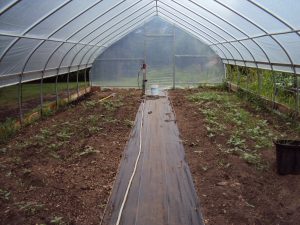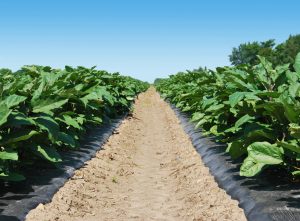In this Issue:
- Seed Potato Handing: Best management practices from storage to planting
- Transplant Sanitation: Ensure healthy vegetables early on for disease-free production long term
- Weed Control: Remove nearby weeds in growing site as they can serve as alternate hosts for common pests
Seed Potato Storage + Handling
Overview

Garden folklore suggests “potatoes in the ground by Good Friday”. However, there are several variables one should consider before planting to promote pest-free potato production. These should include:
Potato Variety/Seed Sourcing
Commercial growers (and home gardeners) should source seed that has been grown in a disease-free area and have passed certification. If tuber or seed pieces show any sign of decay it should not be planted. Make sure cut seed has at least one eye and weighs 1.5-2 oz.
Storage (Temperature, Humidity, and Duration)
Seed potatoes are best stored at 36-40°F with 95% relative humidity. Allow tubers to warm up to 50-55°F for 2 weeks prior to planting (cut seed can be planted immediately).
Seed Maturity
The physiological age of a potato tuber is its measure of stress, health, and metabolism. It can be influenced by temperature, moisture, and maturity in storage conditions. It can also be influenced by its growing environment and the way it had been handled.
Be gentle when transporting seed, it is essential to prevent bruising as that can serve as entry sites for infection.
Diseases that can typically affect seed potatoes include Pectobacterium (Erwinia), carotovora soft rot, Fusarium dry rot, Rhizoctronia sprout girdling, silver scurf, late blight, verticillium, common scab, powdery scab, and ring rot. All of these are usually associated with emergence and stand problems. If you are using pre-cut seed, ensure that all the wound healing requirements are met.
Variety Suggestions
The following varieties are recommendations from University of Idaho Commercial Potato Production in North America
Early Type: CalWhite, Irish Cobbler, Russett Norkotah, Dark Red Norland, and Norland
Mid-Season Type: French Fingerling, Gold Rush, NorValley, Chieftain, Red La Soda, and Red Pontiac
Late-Season Type: Bannock Russet, Katahdin, Russet Burbank, Yukon Gold, IdaRose, Russian Banana and WesternRusset
Additional Resources
Selecting, Cutting and Handling Potato Seed (Maine Extension)
Potato Seed Management (University of Idaho)
Handling Seed Potatoes (University of Wisconsin)
Potato Seed Management Presentation, Dr. Gary Secor, North Dakota State University
Potato – Seed Handling and Treatment (Utah Vegetable Production & Pest Management Guide)
Transplant Sanitation
Overview

During this early spring season; greenhouse, high tunnel, and field sanitation are important for disease and pest management when preparing seedlings for transplanting.
Management
Greenhouse/Hightunnel Sanitation
Ensure the interior area is free of old plant debris and weeds. Ground and benches should be sterilized before planting.
Ventilation
Good airflow in the space is important to keep foliage dry and extenuating bacterial and fungal diseases.
Growing Cells/Trays
The size of cells used can have an impact on the spread of disease, as closely packed cells are likely to have increased relative humidity and create a more desired condition for disease spread. Between uses ALWAYS sanitize trays and cells.
Growing Medium
The best growing mediums have good drainage, moisture-holding capacity, and high nutrient retention capability. These mixes should also be sterile and free of any pesticide residues.
Irrigation Management
Proper irrigation is critical to producing healthy transplants for vegetable fields. Overwatering and the presence of standing water can increase the risk of disease spread. Irrigation is best done in the morning to allow foliage surface to dry before the night.
Additional Resources
IPM for Greenhouse & Nursery Crops (Presentation)
Proper Transplant Production is Key to Healthy and High Yielding Crops (Article)
Sanitation When Transition High Tunnels (Article)
Vegetable Transplant Production (USU Fact Sheet)
Weed Control
Overview

Weed control is a tedious but necessary task for all farmers and gardeners. Weeds are a threat because they take away things that cash crops need to survive. Such as sun, water, and nutrients. Specific species of weeds (such as those in the Brassicaceae and Solanaceae families) are known to harbor insect and disease pests that can later target vegetable crops. With Integrated Pest Management we can control weeds through mechanical, cultural, chemical, or biological methods.
Management
Individual Removal
The most traditional way of weed removal is using hand tools. Common tools for this include a shovel, rake, and hoe.
Mulching
Mulching is a way of cultural control that uses a cover to block the soil surface preventing weed germination and growth. There are all sorts of materials one can use for mulching their vegetable crops. This includes organic materials such as straw, wood chips, or leaves. There are also synthetic materials available such as plastic or paper rolls.
Mowing
Cutting back weeds can prevent the species from developing to the seed stage. Lawn mowers and string trimmers (“weed eaters”) are generally effective.
Herbicides
Herbicides are used as a chemical method of weed control. However, it is important to know that herbicides are not appropriate for all growing situations as there is a risk of drift that can damage desirable plants and promote colonization of tolerant weed species. Herbicides can either be selective (plant specific) or nonselective (affect all treated plants). Herbicides can be applied to the soil or the foliage near the production site.
Additional Resources
Registered Herbicide Options for Vegetable Production (Utah Vegetable Production & Pest Management Guide)
Weed Control Chapter (USU Master Gardener Program)
Common Weeds of the Yard and Garden (USU Field Guide)
How to Prevent Weeds: Fence Lines (Video)
How to Prevent Weeds: Equipment Cleaning (Video)
How to Prevent Weeds: Healthy Fields (Video)
Sustainable Weed Management (Webinar)
